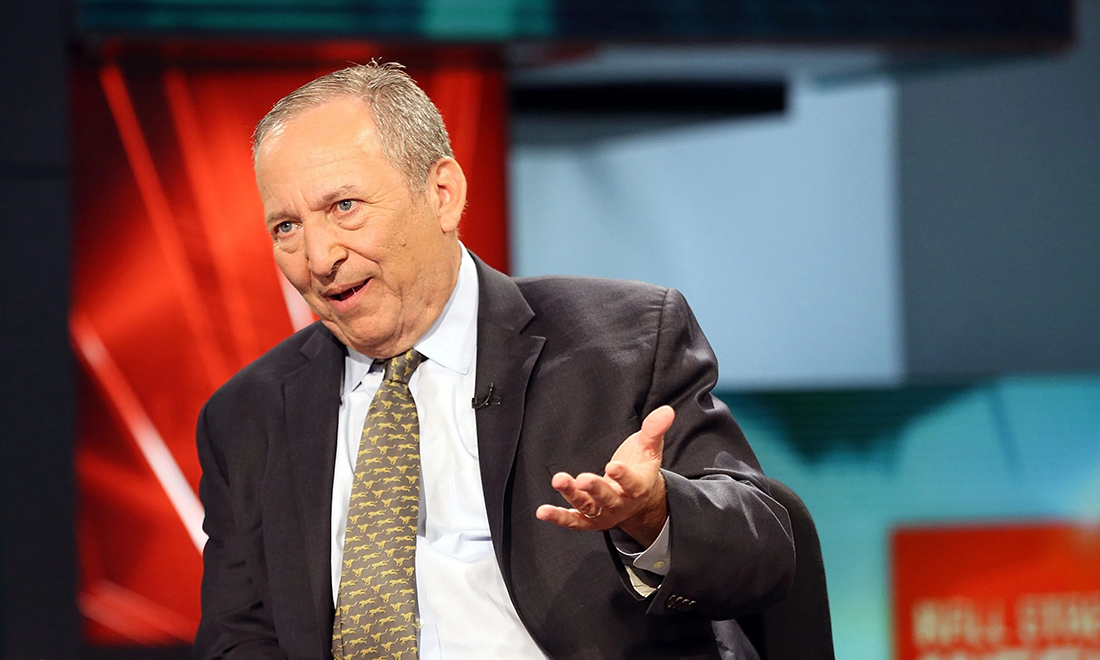
前美國(guó)財(cái)長(zhǎng)拉里·薩默斯擔(dān)心,“默默放棄進(jìn)取”的趨勢(shì)正在損害美國(guó)工人的生產(chǎn)率,。
薩默斯是一位資深經(jīng)濟(jì)學(xué)家,,曾擔(dān)任哈佛大學(xué)(Harvard University)校長(zhǎng)和世界銀行(World Bank)首席經(jīng)濟(jì)學(xué)家,。他會(huì)參與討論這個(gè)在社交媒體上走紅的新詞匯,讓人們覺(jué)得不可思議,。
但在回應(yīng)諾貝爾獎(jiǎng)得主保羅·克魯格曼周五在《紐約時(shí)報(bào)》發(fā)表的一篇專欄文章時(shí),,67歲的薩默斯表示,他認(rèn)為“默默放棄進(jìn)取”是美國(guó)第二季度工人生產(chǎn)率下降4.1%的主要原因之一,?!澳艞夁M(jìn)取”是一個(gè)非正式的術(shù)語(yǔ),是指人們只做最低限度的工作,,放棄做超出工作范圍的任務(wù),。
今年早些時(shí)候,這個(gè)詞在TikTok和Instagram等平臺(tái)上走紅,。多年來(lái),,聽夠了“努力要趁早”和“向前一步”這樣的工作建議,80%的Z世代和千禧一代上班族認(rèn)為現(xiàn)在的趨勢(shì)對(duì)他們很有吸引力,。
薩默斯擔(dān)心,,這些默默放棄進(jìn)取的人們會(huì)導(dǎo)致通脹高企的狀況進(jìn)一步惡化。9月美國(guó)的通脹率達(dá)到8.2%,。通脹持續(xù)會(huì)迫使美聯(lián)儲(chǔ)不得不繼續(xù)加息,,最終導(dǎo)致經(jīng)濟(jì)衰退。
他周一在一條推文中表示:“由于生產(chǎn)率增長(zhǎng)停滯,,原因可能是默默放棄進(jìn)取的趨勢(shì),,要想實(shí)現(xiàn)持續(xù)幾個(gè)月將通脹維持在2%左右的目標(biāo),必須大幅減慢工資增長(zhǎng)速度,。我認(rèn)為相信這種觀念,,必定會(huì)引發(fā)嚴(yán)重的經(jīng)濟(jì)衰退?!?/p>
在2005年發(fā)表的一篇文章中,,時(shí)任舊金山聯(lián)邦儲(chǔ)備銀行(Federal Reserve Bank of San Francisco)行長(zhǎng)兼首席執(zhí)行官的現(xiàn)任財(cái)政部長(zhǎng)珍妮特·耶倫,分析了工人生產(chǎn)率下降與通脹之間的關(guān)系,,這正是薩默斯最近所討論的話題,。
耶倫表示,工人生產(chǎn)率下降,,會(huì)迫使企業(yè)招聘更多員工完成相同的工作,。這導(dǎo)致成本上漲,而企業(yè)會(huì)通過(guò)漲價(jià)來(lái)轉(zhuǎn)嫁成本,。耶倫承認(rèn)這是一個(gè)惡性循環(huán),,會(huì)在“很長(zhǎng)時(shí)間內(nèi)”帶來(lái)“通脹上行壓力”。
“默默放棄進(jìn)取”是否是工人生產(chǎn)率下降的真正原因?
薩默斯認(rèn)為工人生產(chǎn)率下降加劇通脹,,他的觀點(diǎn)有過(guò)去所做的研究提供佐證,。但他所說(shuō)的默默放棄進(jìn)取所產(chǎn)生的影響,很快就遭到了同行的質(zhì)疑,。
薩默斯的話尤其是引起了一些進(jìn)步經(jīng)濟(jì)學(xué)家們的不滿。他主張,,為了控制通脹應(yīng)該降低工人工資(提高失業(yè)率),,同時(shí)討論了默默放棄進(jìn)取的趨勢(shì)如何演變成了對(duì)經(jīng)濟(jì)學(xué)家們?nèi)绾慰创齽趧?dòng)力的一場(chǎng)羅爾沙赫氏試驗(yàn)。進(jìn)步經(jīng)濟(jì)學(xué)家們批評(píng)薩默斯稱,,不能簡(jiǎn)單地把提高失業(yè)率作為宏觀經(jīng)濟(jì)解決方案,。
Fastmarkets RISI資深經(jīng)濟(jì)學(xué)家達(dá)斯汀·賈爾伯特表示,在討論美聯(lián)儲(chǔ)政策時(shí),,最好不要把關(guān)注點(diǎn)放在默默放棄進(jìn)取這些缺少經(jīng)驗(yàn)證據(jù)支持的趨勢(shì),。
賈爾伯特在回應(yīng)薩默斯時(shí)表示:“搞笑的是,一些重量級(jí)經(jīng)濟(jì)學(xué)家對(duì)于不遵循傳統(tǒng)宏觀框架下的通脹經(jīng)驗(yàn)證據(jù)的同行大肆批評(píng),,但同時(shí)自己卻認(rèn)為默默放棄進(jìn)取是真實(shí)存在的,,而不是社交媒體上的一個(gè)梗?!?/p>
賈爾伯特還表示,,薩默斯準(zhǔn)確預(yù)測(cè)了通脹上漲,這一點(diǎn)值得稱贊,,但他可能“太相信勞動(dòng)市場(chǎng)上的奇聞異事”,,因?yàn)樗鼈兒芷鹾纤摹笆澜缬^”,盡管沒(méi)有任何證據(jù)能夠證明它們的存在,。
前美聯(lián)儲(chǔ)經(jīng)濟(jì)學(xué)家,、Sahm Consulting公司的創(chuàng)始人克勞迪亞·薩姆進(jìn)一步表示,她對(duì)薩默斯提出的“經(jīng)濟(jì)分析和政策建議感到不安”,。
她周一發(fā)推文回復(fù)薩默斯的評(píng)論稱:“通貨緊縮即將來(lái)臨,。美聯(lián)儲(chǔ)需要停止行動(dòng)。它已經(jīng)做得夠多了,?!?/p>
雖然默默放棄進(jìn)取的趨勢(shì)確實(shí)在社交媒體上流行,但在實(shí)際數(shù)據(jù)中并沒(méi)有太多證據(jù)能證明這種趨勢(shì),,而且工人生產(chǎn)率下降還有其他潛在原因,,例如后疫情時(shí)代的工作技能缺口和消費(fèi)者支出放緩等。
以員工參與度調(diào)查為例,。2000年,,蓋洛普(Gallup)調(diào)查發(fā)現(xiàn),26%的員工表示在工作中的參與度較高,有18%的受訪者表示“工作參與度極低”,。但去年,,這兩個(gè)比例分別為34%和16%。
蓋洛普過(guò)去二十年的員工參與度調(diào)查持續(xù)表明,,盡管最近TikTok上出現(xiàn)了各種新趨勢(shì),,但員工的工作參與度卻不降反升。
這種趨勢(shì)或許會(huì)發(fā)生變化,,但目前證明“默默放棄進(jìn)取”對(duì)經(jīng)濟(jì)產(chǎn)生任何實(shí)際影響的證據(jù)有限,。有許多人認(rèn)為這種趨勢(shì)只是代表人們?cè)谧鲎约旱谋韭毠ぷ鳌?/p>
美國(guó)兩黨公共政策組織經(jīng)濟(jì)創(chuàng)新集團(tuán)(Economic Innovation Group)的首席經(jīng)濟(jì)學(xué)家亞當(dāng)·奧濟(jì)梅克周一發(fā)推文稱:“我并不認(rèn)為默默放棄進(jìn)取是真實(shí)存在的,或者正在影響生產(chǎn)率提高,。我認(rèn)為更有可能產(chǎn)生影響的是實(shí)際辭職者,,以及大量人才流失和新員工入職。這會(huì)導(dǎo)致利率上漲和勞動(dòng)力供應(yīng)增長(zhǎng),,事實(shí)上這些影響已經(jīng)發(fā)生,。”(財(cái)富中文網(wǎng))
翻譯:劉進(jìn)龍
審校:汪皓
前美國(guó)財(cái)長(zhǎng)拉里·薩默斯擔(dān)心,,“默默放棄進(jìn)取”的趨勢(shì)正在損害美國(guó)工人的生產(chǎn)率,。
薩默斯是一位資深經(jīng)濟(jì)學(xué)家,曾擔(dān)任哈佛大學(xué)(Harvard University)校長(zhǎng)和世界銀行(World Bank)首席經(jīng)濟(jì)學(xué)家,。他會(huì)參與討論這個(gè)在社交媒體上走紅的新詞匯,,讓人們覺(jué)得不可思議。
但在回應(yīng)諾貝爾獎(jiǎng)得主保羅·克魯格曼周五在《紐約時(shí)報(bào)》發(fā)表的一篇專欄文章時(shí),,67歲的薩默斯表示,,他認(rèn)為“默默放棄進(jìn)取”是美國(guó)第二季度工人生產(chǎn)率下降4.1%的主要原因之一?!澳艞夁M(jìn)取”是一個(gè)非正式的術(shù)語(yǔ),,是指人們只做最低限度的工作,放棄做超出工作范圍的任務(wù),。
今年早些時(shí)候,,這個(gè)詞在TikTok和Instagram等平臺(tái)上走紅。多年來(lái),,聽夠了“努力要趁早”和“向前一步”這樣的工作建議,,80%的Z世代和千禧一代上班族認(rèn)為現(xiàn)在的趨勢(shì)對(duì)他們很有吸引力。
薩默斯擔(dān)心,,這些默默放棄進(jìn)取的人們會(huì)導(dǎo)致通脹高企的狀況進(jìn)一步惡化,。9月美國(guó)的通脹率達(dá)到8.2%。通脹持續(xù)會(huì)迫使美聯(lián)儲(chǔ)不得不繼續(xù)加息,,最終導(dǎo)致經(jīng)濟(jì)衰退,。
他周一在一條推文中表示:“由于生產(chǎn)率增長(zhǎng)停滯,,原因可能是默默放棄進(jìn)取的趨勢(shì),要想實(shí)現(xiàn)持續(xù)幾個(gè)月將通脹維持在2%左右的目標(biāo),,必須大幅減慢工資增長(zhǎng)速度,。我認(rèn)為相信這種觀念,必定會(huì)引發(fā)嚴(yán)重的經(jīng)濟(jì)衰退,?!?/p>
在2005年發(fā)表的一篇文章中,時(shí)任舊金山聯(lián)邦儲(chǔ)備銀行(Federal Reserve Bank of San Francisco)行長(zhǎng)兼首席執(zhí)行官的現(xiàn)任財(cái)政部長(zhǎng)珍妮特·耶倫,,分析了工人生產(chǎn)率下降與通脹之間的關(guān)系,,這正是薩默斯最近所討論的話題。
耶倫表示,,工人生產(chǎn)率下降,會(huì)迫使企業(yè)招聘更多員工完成相同的工作,。這導(dǎo)致成本上漲,,而企業(yè)會(huì)通過(guò)漲價(jià)來(lái)轉(zhuǎn)嫁成本。耶倫承認(rèn)這是一個(gè)惡性循環(huán),,會(huì)在“很長(zhǎng)時(shí)間內(nèi)”帶來(lái)“通脹上行壓力”,。
“默默放棄進(jìn)取”是否是工人生產(chǎn)率下降的真正原因?
薩默斯認(rèn)為工人生產(chǎn)率下降加劇通脹,,他的觀點(diǎn)有過(guò)去所做的研究提供佐證,。但他所說(shuō)的默默放棄進(jìn)取所產(chǎn)生的影響,很快就遭到了同行的質(zhì)疑,。
薩默斯的話尤其是引起了一些進(jìn)步經(jīng)濟(jì)學(xué)家們的不滿,。他主張,為了控制通脹應(yīng)該降低工人工資(提高失業(yè)率),,同時(shí)討論了默默放棄進(jìn)取的趨勢(shì)如何演變成了對(duì)經(jīng)濟(jì)學(xué)家們?nèi)绾慰创齽趧?dòng)力的一場(chǎng)羅爾沙赫氏試驗(yàn),。進(jìn)步經(jīng)濟(jì)學(xué)家們批評(píng)薩默斯稱,不能簡(jiǎn)單地把提高失業(yè)率作為宏觀經(jīng)濟(jì)解決方案,。
Fastmarkets RISI資深經(jīng)濟(jì)學(xué)家達(dá)斯汀·賈爾伯特表示,,在討論美聯(lián)儲(chǔ)政策時(shí),最好不要把關(guān)注點(diǎn)放在默默放棄進(jìn)取這些缺少經(jīng)驗(yàn)證據(jù)支持的趨勢(shì),。
賈爾伯特在回應(yīng)薩默斯時(shí)表示:“搞笑的是,,一些重量級(jí)經(jīng)濟(jì)學(xué)家對(duì)于不遵循傳統(tǒng)宏觀框架下的通脹經(jīng)驗(yàn)證據(jù)的同行大肆批評(píng),但同時(shí)自己卻認(rèn)為默默放棄進(jìn)取是真實(shí)存在的,,而不是社交媒體上的一個(gè)梗,。”
賈爾伯特還表示,,薩默斯準(zhǔn)確預(yù)測(cè)了通脹上漲,,這一點(diǎn)值得稱贊,,但他可能“太相信勞動(dòng)市場(chǎng)上的奇聞異事”,因?yàn)樗鼈兒芷鹾纤摹笆澜缬^”,,盡管沒(méi)有任何證據(jù)能夠證明它們的存在,。
前美聯(lián)儲(chǔ)經(jīng)濟(jì)學(xué)家、Sahm Consulting公司的創(chuàng)始人克勞迪亞·薩姆進(jìn)一步表示,,她對(duì)薩默斯提出的“經(jīng)濟(jì)分析和政策建議感到不安”,。
她周一發(fā)推文回復(fù)薩默斯的評(píng)論稱:“通貨緊縮即將來(lái)臨。美聯(lián)儲(chǔ)需要停止行動(dòng),。它已經(jīng)做得夠多了,。”
雖然默默放棄進(jìn)取的趨勢(shì)確實(shí)在社交媒體上流行,,但在實(shí)際數(shù)據(jù)中并沒(méi)有太多證據(jù)能證明這種趨勢(shì),,而且工人生產(chǎn)率下降還有其他潛在原因,例如后疫情時(shí)代的工作技能缺口和消費(fèi)者支出放緩等,。
以員工參與度調(diào)查為例,。2000年,蓋洛普(Gallup)調(diào)查發(fā)現(xiàn),,26%的員工表示在工作中的參與度較高,,有18%的受訪者表示“工作參與度極低”。但去年,,這兩個(gè)比例分別為34%和16%,。
蓋洛普過(guò)去二十年的員工參與度調(diào)查持續(xù)表明,盡管最近TikTok上出現(xiàn)了各種新趨勢(shì),,但員工的工作參與度卻不降反升,。
這種趨勢(shì)或許會(huì)發(fā)生變化,但目前證明“默默放棄進(jìn)取”對(duì)經(jīng)濟(jì)產(chǎn)生任何實(shí)際影響的證據(jù)有限,。有許多人認(rèn)為這種趨勢(shì)只是代表人們?cè)谧鲎约旱谋韭毠ぷ鳌?/p>
美國(guó)兩黨公共政策組織經(jīng)濟(jì)創(chuàng)新集團(tuán)(Economic Innovation Group)的首席經(jīng)濟(jì)學(xué)家亞當(dāng)·奧濟(jì)梅克周一發(fā)推文稱:“我并不認(rèn)為默默放棄進(jìn)取是真實(shí)存在的,,或者正在影響生產(chǎn)率提高。我認(rèn)為更有可能產(chǎn)生影響的是實(shí)際辭職者,,以及大量人才流失和新員工入職,。這會(huì)導(dǎo)致利率上漲和勞動(dòng)力供應(yīng)增長(zhǎng),事實(shí)上這些影響已經(jīng)發(fā)生,?!保ㄘ?cái)富中文網(wǎng))
翻譯:劉進(jìn)龍
審校:汪皓
Former Treasury Secretary Larry Summers is worried that “quiet quitters” are hurting U.S. worker productivity.
A veteran economist who previously served as president of Harvard University and chief economist at the World Bank, Summers is an unlikely figure to be discussing the new phrase that has caught fire on social media.
But in response to Nobel laureate Paul Krugman’s Friday New York Times op-ed, the 67-year-old said that he believes “quiet quitting,” an informal term for people who give up on going above and beyond at their jobs and just do the bare minimum, is one of the key reasons that U.S. workers’ productivity fell 4.1% in the second quarter.
The term “quiet quitting” took off on platforms like TikTok and Instagram earlier this year. After years of receiving “rise and grind” and “l(fā)ean in” work advice, 80% of Gen Z and millennial workers say the trend appeals to them.
Summers fears that these quiet quitters will exacerbate already elevated inflation, which came in at 8.2% in September, forcing the Federal Reserve to continue raising interest rates and spark a recession.
“Given dismal productivity growth, likely caused by quiet quitting, wage inflation will have to come down significantly if sustained months near 2% inflation is to be attained,” Summers wrote in a Monday tweet. “I do not understand the basis for believing this is likely without a meaningful recession.”
In a 2005 paper, Treasury Secretary Janet Yellen, who at the time served as president and chief executive officer of the Federal Reserve Bank of San Francisco, described the connection between falling worker productivity and inflation that Summers is discussing here.
She wrote that when workers’ productivity drops, it forces businesses to hire more employees to complete the same job. That leads to rising costs, which businesses then pass on by raising prices. It’s a vicious cycle that Yellen admitted can cause “upward pressure on inflation” for a “considerable period.”
Is ‘quiet quitting’ really the cause of slowing worker productivity?
Summers’ argument about falling worker productivity exacerbating inflation has been backed up by research in the past. But his comments about how quiet quitting has factored in were immediately questioned by his fellow economists.
Summers struck a nerve among progressives, in particular, because his argument that workers will have to be paid less (with higher unemployment) to rein in inflation touches on how the quiet quitting trend has turned into a kind of Rorschach test for how economists think about labor. The progressives who criticized Summers say it’s just not as simple as higher unemployment being the macroeconomic solution.
Dustin Jalbert, a senior economist at Fastmarkets RISI, said that it may not be the best policy to look at trends like quiet quitting that aren’t backed up by empirical evidence when discussing Fed policy.
“It’s pretty funny to see heavyweight economists dishing out critiques of those not following empirical evidence on inflation from traditional macro frameworks, yet in the same breath assuming quiet quitting is real and not a meme from social media,” Jalbert wrote in response to Summers.
Jalbert went on to say that Summers deserves credit for correctly predicting the rise of inflation, but that he may be “clinging to labor market anecdotes” that fit his “worldview” even when the evidence is lacking.
Claudia Sahm, a former Fed economist and the founder of Sahm Consulting, went a step further, saying that she is “deeply disturbed by the economic analysis and policy advice” that Summers is dishing out.
“Disinflation is coming. The Fed needs to back off. It’s done enough,” she wrote in a Monday tweet, responding to Summers’ comments.
While quiet quitting has undoubtedly taken off on social media, there isn’t much evidence of the trend in real-world data, and there are several other potential causes for slowing productivity, like a post-pandemic jobs skills gap and slowing consumer spending.
Take worker engagement polls as an example. In 2000, Gallup found that 26% of employees said they were engaged at work, while 18% said they were “actively disengaged.” But last year, 34% of workers said they were engaged at work, while only 16% said they were “actively disengaged.”
Gallup’s worker engagement polls from the past two decades consistently show that, despite any recent TikTok trends, workers have become more engaged at work, not less engaged.
That trend may change, but for now, there is limited evidence that “quiet quitting,” which many have pointed out is in fact people just doing their jobs, is having any real impact on the economy.
“I don’t think quiet quitting is real or affecting productivity growth,” Adam Ozimek, chief economist at bipartisan public policy organization Economic Innovation Group, wrote in a Monday tweet. “I think more likely it is actual quitting, and resulting high levels of churn and onboarding. And this will come down with rate hikes and labor supply growth, and indeed it already is.”






